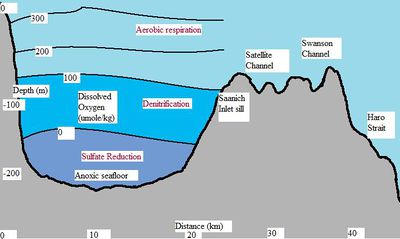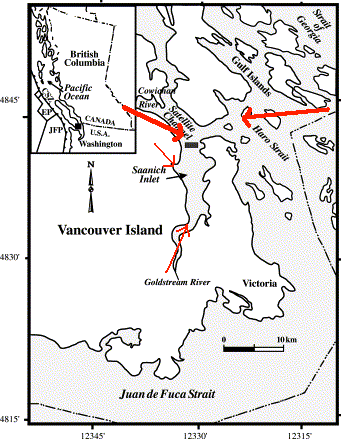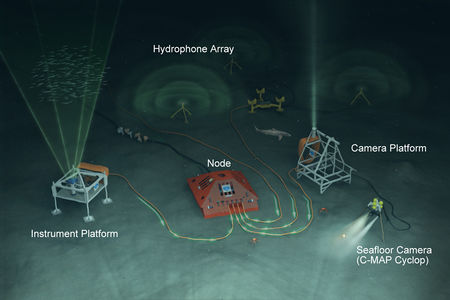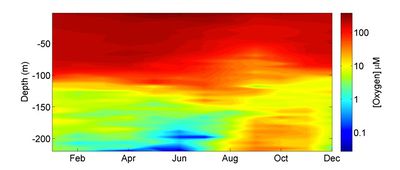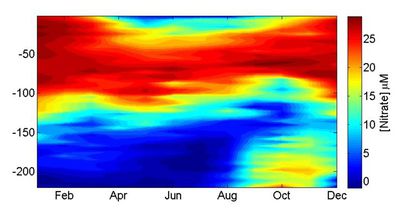Saanich inlet
Introduction
Saanich Inlet on Vancouver Island in British Columbia, Canada, is a 24 km long coastal fjord characterized by a stable, seasonally influenced oxygen minimal zone. Water movement is restricted at the entrance to the inlet creating stable hydrological conditions. A 75 meter sill protects deeper waters, a maximum depth of 235 meters, from disruption [1]. Limited deep-water circulation, and high organic input from freshwater discharge and sedimenting phytoplankton in surface waters [2] lead to anoxic conditions below 110 meters [1]. Seasonal oxygen replenishment, primarily in the fall, modifies the oxygen gradient [3] and affects environmental conditions for microbial communities within the fjord. The inlet’s tidal cycle and interrelated oxygen gradient have been documented for decades. Accordingly, this coastal fjord is ideal for in situ research and a model for microbial interactions in Oxygen Minimum Zones (OMZ). Similar environments include permanent anoxic zones in the Arabian Seas and the Bay of Bengal and semi enclosed basins such as the Black Sea [4] and the Aitoliko lagoon in Greece [5].
History
The local properties of the Saanich Inlet marine system have been researched since 1927 [1]. In 1962, R.H. Herlinveaux published a compilation of oceanographic data about the inlet, including an assessment of oxygen concentration throughout the year [1] and a focus on monthly variations in sound velocity underwater [1]. In 1973, Anderson and Devol documented deep water renewal in the water basin, qualifying the inlet as intermittently anoxic [3]. Research has been done to understand nutrient cycling in oxygen deficient environments and the impact of microorganisms on nitrogen, sulfur, methane and oxygen availability in this ecosystem [3][6]. Current interest includes the microbial community’s impact on greenhouse gas release [7][8].
VENUS Observatory
The underwater multi sensor station of the Victoria Experimental Network Under the Sea (VENUS), at a depth of 97 meters, went in operation in February 2006. It allows scientists and the public to access data, including live videos, of a permanent monitoring system on the seafloor. VENUS offers archived data, provides remote control of the instruments such as physical and chemical sensors for sampling and permits real time connection to the station [9]. The research station is at the core of the inlet’s oceanographic seasonal anoxia studies.
Chemical environment
Oxygen
Dissolved oxygen concentration is at a minimum at the anoxic (01-1.0 μM of dissolved O2) seafloor and gradually increases through the hypoxic zone at intermediate depth before reaching its highest concentration at the surface [8]. Fresh water runoff into the inlet fuels high primary productivity and rapid O2 consumption by phytoplankton near the surface [10][6][2]. Aerobic microorganisms at greater depth depend on cyclic oxygen input from deep water renewal [8][11].
Nitrogen
Oxygen depletion from rapid consumption after deep-water oxygenation is followed by nitrate (NO3-) reduction by denitrifiers resulting in a steep nitrate gradient [8] [6]. Denitrification and the anammox reaction, nitrite (NO2-) reduction and ammonium (NH4+) oxidation resulting in dinitrogen gas (N2), are the prevailing mechanisms for loss of bioavailable nitrogen in the inlet and in most ocean ecosystems around the world [7].
Sulfur
Near the seafloor, sulfate (SO42-) reduction succeeds denitrification, producing hydrogen sulfide (H2S) in late spring and summer when nitrate and oxygen are at their lowest concentration [3]. Using the VENUS station, the formation of bacterial mats of the anaerobic sulfate reducer Beggiatoa spp have been observed retreating into seafloor sediments in the event of deep water renewal until oxygen depletion [11].
Carbon
Methane
Methane (CH4) oxidation occurs in both the oxic and the anoxic regions of the water column, but at much higher rates under aerobic conditions. Notably, methylotroph belonging to the orders of methylophilaceae and methylococcales have been documented in the aerobic and hypoxic zones respectively [12]. Little is known of the methanotrophic bacteria and their contribution to methane emissions regulation [12].
Current Research
Fixed Nitrogen Loss
Current research includes investigation of the nitrogen cycle in intermittently anoxic water by Manning et al. [7]. Dissolved dinitrogen concentration profiles have been compared to other marine systems to determine biological N2 gas flux within the inlet’s water column. Comparing biological N2 production in the water column throughout the year, they were able to estimate that 45% of the water below 130 meters was renewed in the fall [7]. Subsequent high rate of fixed nitrogen loss, over the winter months, is attributed to deep-water renewal events pushing organic matter, nitrate and oxygen to the otherwise stagnant bottom water [3] [7]. Availability of fixed nitrogen is the main factor limiting carbon sequestration by primary producers.
Methanotrophic Communities
Sauter et al. investigated the diversity of microorganisms in relation to methane concentration [12]. This study used Flow Cytometry Based Redox Sensing of actively metabolizing microbes and PCR analysis of 16S rRNA and the gene markers pmoA and fhcD to document the microbial community response to methane addition. Two yet uncultivated groups belonging to Gammaproteobacteria and Planctomycetes were found to possess pmoA and/or fhcD, indicating methanotrophic activity. The abundance of certain Cycloclasticus-like sequences suggests some members of this group also contribute to methane cycling. The influence of deep-water renewal on these newly discovered organisms still have to be determined [12].
Microorganisms and the Chemical Environment
Zalkova et al. documented the microbial community response to variations in dissolved oxygen concentration in the inlet to determine how the oxygen gradient shapes ecosystems [8]. Comparing concentrations of dissolved chemicals at various depths to cell abundance confirmed that the transition zone at intermediate depth has the greatest microbial diversity (Fig6). SSU rRNA gene DGGE profiles from samples taken at specific depths at different times of the year were used to document changes within the bacterial community and identify dominant bacterial groups. Nitrospina and SAR324 (d-proteobacteria) and thiotrophic SUP05 (y-proteobacteria) were predominant in the anoxic basin except during deep-water renewal events. Also, 100 meter profiles in the fall are similar to profiles found at 120 m throughout the year, confirming the shoaling of bottom water toward the surface [8].
Global Implication
Oceanic microbiota plays a major role in nutrients cycling between biologically available nutrients for primary producers, such as nitrate for plants, and unavailable forms like dinitrogen gas. In addition, understanding community dynamics and influential factors within the fjord is critical to understand the microorganisms’ influence on greenhouse gas emissions, notably methane and dinitrogen. The microbial community’s response to changing environmental conditions, such as coastal water eutrophication from agricultural runoff, can also be predicted using model ecosystems such as the Saanich Inlet.
References
(1) Herlinveaux, R., H. ‘‘Oceanography of Saanich Inlet in Vancouver Island, British Columbia.’’ Journal Fisheries Research Board of Canada, vol. 19, no1, 1962. (2) Gargett, A., E., Stucchi, D., Whitney, F. ‘‘Physical processes associated with high primary production in Saanich Inlet, British Columbia.’’ Science direct, 2003, DOI:10.1016/S0272-7714(02)00319-0 (3) Anderson, J., J., Devol, A., H. ‘‘Deep water renewal in Saanich Inlet, an intermittently anoxic basin.’’ Estuarine and Coastal Marine Science, 1973 (4) Naqvi, S.W.A., Bange, H.W., Farias, L., Monteiro, P.M.S., Scranton, M.I., Zhang, J., ‘‘Marine hypoxia/anoxia as a source of CH4 and N20.’’ European Geosciences Union, Biogeosciences, vol. 7(7), 2010. http://drs.nio.org/drs/handle/2264/3654. (5) Gianni, A., Zacharias, I. ‘‘Morphology and anoxia in enclosed seas: Aitoliko lagoon – Greece.’’ Geophysical Research, vol 13, 2011. (6) Hobson, L., A. ‘‘Seasonal variations and spatial gradients of nitrogenous nutrients in waters of southeastern Vancouver Island, British Columbia, Canada.’’ Netherlands Journal of Sea Research, vol. 19, 1985 (7) Manning, C., C., Hamme, R., C., Bourbonnais, A. ‘‘Impact of deep-water renewal events on fixed nitrogen loss from seasonally-anoxic Saanich Inlet.’’ Elsevier, 2010, DOI: 10.1016/j.marchem.2010.08.002 (8) Zalkova ,E., Walsh ,A., D., Stillwell, C., P., Mohn, W., W., Tortell, P., D. and Hallam, S., J. ‘‘Microbial community dynamics in a seasonally anoxic fjord: Saanich Inlet, British Columbia.’’ Environmental Microbiology, 2010, DOI:10.111/j.1462-2920.2009.02058.x (9) VENUS, www.venus.uvic.ca, 2012 (10) Timothy, D., A., Soon, M., Y., S. ‘‘Primary production and deep-water oxygen content of two British Columbian fjords.’’ Marine Chemistry, 2001, PII:S0304-4203(00)00071-2 (11) Matabos, M., Aguzzi, J., Robert, K., Costa, C., Menesatti, P., Company, J.,B., Juniper, S., K. ‘‘Multi-parametric study of behavioural modulation in demersal decapods at the VENUS cabled observatory in Saanich Inlet, British Columbia, Canada.’’ Elsevier, 2011, DOI:10.1016/j.jembe2011.02.041. (12) Sauter, M., L., Latypova, E., Smalley, N., E., Lidstrom, M., E., Hallam, S., Kalyushnaya, M., G. ‘‘Methanotrophic communities of Saanich Inlet: A microcosm perspective.’’ Elsevier, 2011, DOI:10.1016/j.syapm2011.10.006
